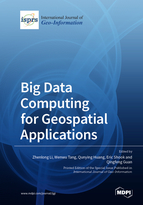Big Data Computing for Geospatial Applications
A special issue of ISPRS International Journal of Geo-Information (ISSN 2220-9964).
Deadline for manuscript submissions: closed (31 May 2020) | Viewed by 58929
Special Issue Editors
Interests: GIScience; geospatial big data; spatial computing; GeoAI
Special Issues, Collections and Topics in MDPI journals
Interests: geographic information science; spatial cyberinfrastructure; agent-based modeling; land use and land cover change; complex adaptive spatial systems
Special Issues, Collections and Topics in MDPI journals
Interests: spatial big data analytics and mining; cloud computing, distributed computing, and high-performance computing; remote sensing; natural hazards
Special Issues, Collections and Topics in MDPI journals
Interests: geographic information science; cyberGIS; geocomputing; big data analytics and modeling; social media data analytics
Interests: big geospatial data; GeoAI; high-performance GeoComputation; spatiotemporal modeling; land-use and land-cover change; urban informatices
Special Issues, Collections and Topics in MDPI journals
Special Issue Information
Dear Colleagues,
Earth observation systems and model simulations are generating massive volumes of disparate, dynamic, and geographically distributed geospatial data with increasingly finer spatiotemporal resolutions. Meanwhile, the propagation of smart devices and social media also provide extensive geo-information about daily life activities. Efficiently analyzing those geospatial big data streams enables us to investigate unknown and complex patterns and develop new decision-support systems, thus provides unprecedented values for business, sciences, and engineering.
However, handling the "Vs" (volume, variety, velocity, veracity, and value) of big data is a challenging task. This is especially true for geospatial big data since the massive datasets often need to be analyzed in the context of dynamic space and time. Following a series of successful sessions organized at AAG, this special issue on “Big Data Computing for Geospatial Applications” by the ISPRS International Journal of Geo-Information aims to capture the latest efforts on utilizing, adapting, and developing new computing approaches, spatial methods, and data management strategies to tackle geospatial big data challenges for supporting geospatial applications in different domains such as climate change, disaster management, human dynamics, public health, and environment and engineering.
Potential topics include (but are not limited to) the following:
- Geo-cyberinfrastructure integrating spatiotemporal principles and advanced computational technologies (e.g., high-performance computing, cloud computing, and deep learning).
- New computing and programming frameworks and architecture or parallel computing algorithms for geospatial applications.
- New geospatial data management strategies and data storage models coupled with high-performance computing for efficient data query, retrieval, and processing (e.g. new spatiotemporal indexing mechanisms).
- New computing methods considering spatiotemporal collocation (locations and relationships) of users, data, and computing resources.
- Geospatial big data processing, mining and visualization methods using high-performance computing and artificial intelligence.
- Integrating scientific workflows in cloud computing and/or high performance computing environment.
- Any other research, development, education, and visions related to geospatial big data computing.
Interested authors are encouraged to notify the guest editors of their intention by sending an abstract to Dr. Zhenlong Li (zhenlong@sc.edu). The deadline for submissions of the final papers is May 31, 2020. Accepted papers will be published continuously in the journal (as soon as accepted) and will be listed together on the special issue website.
Dr. Zhenlong LiAssoc. Prof. Wenwu Tang
Dr. Qunying Huang
Dr. Eric Shook
Prof. Qingfeng Guan
Guest Editors
Manuscript Submission Information
Manuscripts should be submitted online at www.mdpi.com by registering and logging in to this website. Once you are registered, click here to go to the submission form. Manuscripts can be submitted until the deadline. All submissions that pass pre-check are peer-reviewed. Accepted papers will be published continuously in the journal (as soon as accepted) and will be listed together on the special issue website. Research articles, review articles as well as short communications are invited. For planned papers, a title and short abstract (about 100 words) can be sent to the Editorial Office for announcement on this website.
Submitted manuscripts should not have been published previously, nor be under consideration for publication elsewhere (except conference proceedings papers). All manuscripts are thoroughly refereed through a single-blind peer-review process. A guide for authors and other relevant information for submission of manuscripts is available on the Instructions for Authors page. ISPRS International Journal of Geo-Information is an international peer-reviewed open access monthly journal published by MDPI.
Please visit the Instructions for Authors page before submitting a manuscript. The Article Processing Charge (APC) for publication in this open access journal is 1700 CHF (Swiss Francs). Submitted papers should be well formatted and use good English. Authors may use MDPI's English editing service prior to publication or during author revisions.








